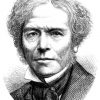Magnetic Personalities: Michael Faraday
To say chemist and physicist Michael Faraday had an impact on our understanding of electromagnetism would be an understatement. In fact, he basically established the field of electromagnetic research. You don’t get a scientific law and a unit of measurement named after you for nothing! In our latest installment of the Magnetic Personalities series, we’re taking a look at this great scientist’s amazing life.
Early Life
Faraday was born in 1791 to a poor family in Surrey, England. His father was a blacksmith who struggled to provide for him and his three siblings. Despite surviving on nothing more than a loaf of bread for an entire week, Faraday’s mother ensured that his inquisitive mind was well-nourished. She fostered in him a love for discovery and nature. Faraday’s formal education mainly came from the church he and his family attended. His first job was an apprenticeship to a book binder. While this profession was a far cry from the chemistry labs and lecture halls in which Faraday would eventually end up, they did afford him the opportunity to read an unlimited amount of books. To compromise for his meager education at home, the young Faraday read every book he could get his hands on. His favorite was the Encyclopedia Britannica. Through his readings, Faraday learned how conduct crude scientific experiments with whatever supplies he found around work or home. This fascination with experimentation and science would pay off. While still a teenager, Faraday was offered an invitation to attend chemistry lectures at the Royal Institution of Britain. After attending these lectures, Faraday immediately sent a (bound) copy of his notebook to chemist Sir David Humphrey. This eventually landed him a job as a lab assistant under Humphrey. Under the watchful eye of Humphrey, Faraday was able to explore the latest findings in chemistry and contribute to his master’s research in significant ways. It is often said that Michael Faraday was Sir David Humphrey’s greatest discovery.Faraday the Chemist
As his apprenticeship continued, Faraday continued to gain notoriety as one of the best chemists in the world. He was the first scientist to produce compounds of carbon and chlorine as well as contribute to the study of metallurgy. At age 30, he worked on improvements to the glass used in the Royal Institutions telescopes. During his work, Faraday discovered the principle of diamagnetism. Diamagnetism describes objects that repel when introduced to a magnetic field or magnetic objects. Diamagnetic materials include hydrogen, nonmetals, and the noble gasses. While Dutch scientist Sebald Justinus discovered principles of diamagnetism a few decades earlier, it was Faraday who named and described it. After this discovery, Faraday turned his attention to exclusively studying magnetism and electricity. Throughout his career, Faraday’s discoveries and research would revolutionize the fields of physics and chemistry. Here are just a few of his other magnetic achievements:- Designed the first successful electromagnetic motor
- Discovery of electromagnetic induction
- Discovery of mutual induction

